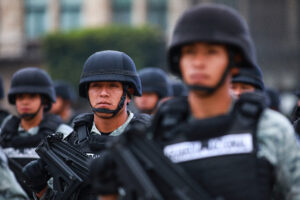By Clay Boggs and Maureen Meyer
The government of Mexico has carried out a very high-profile investigation of the enforced disappearance of 43 students from the Ayotzinapa teachers’ college in Iguala, Guerrero on September 26, 2014. To date, authorities have detained more than 100 individuals in connection with the case. But the investigation has been incomplete, and recent reports bring its shortcomings into focus.
On July 23, 2015, Mexico’s National Human Rights Commission (Comisión Nacional de los Derechos Humanos, CNDH), using its authority to investigate grave human rights violations, submitted a report on the state of the investigation of the students’ disappearance. In issuing the report, the Ombudsman called for breaking apart the alliance between crime and authorities, stating that “we should not wait for another similar or more serious case to happen. The time to act is now.”
SEE ALSO: Analysis and Information on Mexico’s Ayotzinapa Case
Here are six key points from the CNDH report’s set of recommendations for Mexico’s Attorney General’s Office, which point to fairly basic steps in any criminal investigation that Mexican authorities have not yet done.
- Family members of the disappeared students have told CNDH officials that, on September 26 and 27, 2014, three of the disappeared students sent text messages to their family members. A fourth student made a phone call to someone he knew well, on September 26. However, authorities have not yet pinpointed the geographical location of these calls and text messages. Knowing this information would either corroborate or complicate the government’s narrative about the case, depending on what it tells us about where the students were at specific points in time.
- In the narrative presented by then-attorney general Jesus Murillo Karam on January 27, 2015, the students were taken to a trash dump in Cocula, Guerrero, where their bodies were incinerated in a fire. But authorities have yet to request weather data regarding the conditions in that area for September 26 and 27, 2014. If it was raining, it would be significantly less likely that the perpetrators could have built a fire large enough to burn 43 bodies.
- On November 7, 2014, authorities stated that they found six bags with ashes in the San Juan River. They later identified the remains of one student, Alexander Mora Venancio, presumably found in one of those bags; the other remains could not be identified because they had been so burnt. Authorities have not yet ordered out scientific comparisons between the soil that was found in the bags along with the remains, and the soil at the trash dump in Cocula, to see if the samples match. Nor has the government carried out a chemical analysis of the soil found in the bags to determine whether it carries traces of gasoline, which, according to the government’s narrative, was used to fuel the fire.
- Investigators found buttons, buckles, and other objects, both in the bags from the river and at the trash dump. Yet authorities have not shown these items to family members for identification.
- Investigators found shell casings at the trash dump, but have not conducted forensic ballistic tests to determine whether those casings match any of the firearms seized as part of the investigation.
- Multiple items of clothing were found near one of the buses involved in the students’ disappearance. But authorities have not examined this evidence to establish whether these items of clothing contained any biological traces that could be linked through DNA testing.
These points are far from the only concerns regarding the investigation. The students’ families and their legal representatives have strongly questioned the government’s version. In January, they published a list of “10 reasons why the Ayotzinapa case should not be closed” in response to Murillo Karam’s presentation of the “historic truth.” The list noted that multiple lines of investigation, including whether federal authorities had any responsibility, have yet to be pursued. It also noted that the federal government’s narrative fails to account for the homicide of Julio Cesar Mondragon, a student from the Ayotzinapa teachers’ college whose body was discovered with clear signs of torture the day after the forced disappearance.
The CNDH’s report underscores the work that still needs to be done to resolve this case and provide certainty to the family members of the students. No investigation is perfect, and some cases are nearly impossible to fully resolve. But the CNDH’s report makes clear that there are specific and actionable steps that the Mexican government could take to strengthen its investigation and demonstrate that it is serious about getting to the bottom of this case.
The report also contributes to other efforts that have been undertaken to analyze the Mexican government’s investigation into the students’ disappearance and provide technical assistance. Since October 2014, the Argentine Forensic Anthropology Team (Equipo Argentino de Antropología Forense, EAAF), acting on behalf of the students’ families, has accompanied the forensic investigation of the case, issuing a series of statements with observations and recommendations. For example, the EAAF has made clear that it was not initially present when the bags of remains were recovered at the San Juan River, including the bag with remains that were later identified as Alexander Mora Venancio. The EAAF has requested that the Attorney General’s Office confirm the chain of custody of the bags, and also highlighted the lack of scientific evidence linking these bags to the Cocula trash dump.
Furthermore, since March 2015, a group of experts, appointed by the Inter-American Commission on Human Rights under an agreement with the Mexican government and the legal representatives of the family members, has been reviewing the government’s investigation and providing technical assistance for the investigation of the case. This Interdisciplinary Group of Independent Experts (Grupo Interdisciplinario de Expertos y Expertas Independientes, GIEI) has issued four preliminary reports; their final report is due in September. That report will likely provide a more complete assessment of the narrative and analysis of the case.
Addressing the points raised by the CNDH, as well as the concerns that have been raised by the
other experts supporting the investigation, would quickly and comprehensively send a positive signal to the family members, to the survivors of the incident, to the Mexican public, and to the international community about the Mexican government’s commitment to truth, justice, and reparations in this important case.


